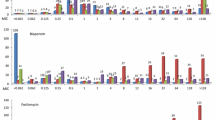Abstract
The in vitro activity of BAY y 3118 against anaerobic cocci,Propionibacterium acnes, Clostridium perfringens, Clostridium difficile, Bacteroides fragilis, otherBacteroides spp. and fusobacteria was determined by an agar dilution method. This activity was compared with that of ciprofloxacin, ofloxacin, piperacillin, cefoxitin, imipenem, clindamycin and metronidazole. BAY y 3118, imipenem, clindamycin and metronidazole were the most active agents tested. The in vitro activity of BAY y 3118 against anaerobic bacteria was superior to that of ciprofloxacin and ofloxacin.
Similar content being viewed by others
References
Holdeman LV, Cato EP, Moore WEC Anaerobe laboratory manual, Virginia Polytechnic Institute and State University, Blacksburg, VA, 1977, p. 1–156.
Dornbusch K, Nord CE, Olsson-Liljequist B Antibiotic susceptibility of anaerobic bacteria with special reference toBacteroides fragilis. Scandinavian Journal of Infectious Diseases 1979, 19: 17–25.
National Committee for Clinical Laboratory Standards Methods for antimicrobial susceptibility testing of anaerobic bacteria, 2nd ed. NCCLS Document M11-A2. National Committee for Clinical Standards, Villanova, PA, 1990.
Author information
Authors and Affiliations
Rights and permissions
About this article
Cite this article
Nord, C.E., Lindmark, A. & Persson, I. In vitro activity of the new quinolone BAY y 3118 against anaerobic bacteria. Eur. J. Clin. Microbiol. Infect. Dis. 12, 640–642 (1993). https://doi.org/10.1007/BF01973648
Issue Date:
DOI: https://doi.org/10.1007/BF01973648




